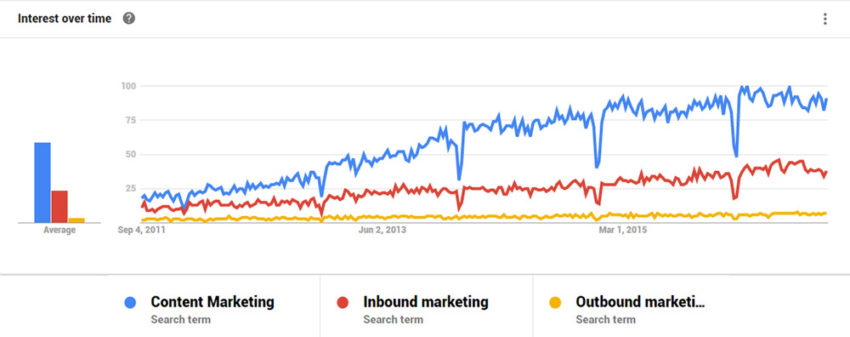New marketing tactics are constantly emerging and shaping the way marketers and businesses engage with their prospects. One promising new tactic, account-based marketing, has emerged within the last three years and is now the buzziest buzz phrase in the marketing world, not to mention the fact that account-based marketing (ABM) has seen tremendous growth with B2B marketing and sales professionals. Today, we are going to look at how ABM exploded into the marketing world and how it may shape the industry moving forward.
ABM began to pick up traction within the marketing industry in 2014. Since then, it’s become a widely-used phrase beyond the marketing industry. One indication of its growing popularity is the growth in search volume which saw interest peak in May 2016.

With growth like this, we wanted to take a look at how we got here and where we see account-based marketing (ABM) going in the future.
How did we get here?
In today’s marketing world, inbound marketing and content marketing have been the tactics driving Business to Consumer (B2C) and Business to Business (B2B) marketing efforts. Everywhere you look, marketing blogs reference these tactics. They have become so widespread and defined in so many ways that it’s become difficult for most people to truly define what they are. To understand how we got here, we need to look at the evolution of marketing tactics:
Inbound marketing – is the promotion of a company or other organization through blogs, newsletters, and social media marketing. The focus is to drive leads into the funnel.
Outbound marketing – is the opposite of inbound marketing and drives leads through paid and organic search, as well as through display networks. The goal is to drive leads into the funnel but is much more disruptive.
Content marketing – is an off shoot of inbound marketing as it is solely based on content created for inbound marketing and not other methods like SEO, freemium trials, and other interactive tools.
And now we have account-based marketing (ABM) which is defined by Wikipedia as “a strategic approach to business marketing in which an organization considers and communicates with individual prospects or customer accounts as markets of one.”
The evolution of marketing tactics that lead to ABM has been driven by marketing technology combined with these tactics over the past five to six years. Search interest for these tactics has shown steady growth from 2011 to 2015 and has now started to flatten out.

We are also seeing trends that align to the search interest over the previous five years as it relates to a company’s decline in satisfaction with content marketing. The Content Marketing Institute (CMI) and MarketingProfs have released their /latest annual report. According to the report, 30% of content marketers rated their organization’s use of content marketing as effective (top-2 box on a 5-point scale), compared to 38% last year, 42% in 2013 and 36% in 2012. This doesn’t necessarily suggest that content marketing isn’t working, rather it may show that we need to shift how we are utilizing the tactic. These trends are some of the leading factors in pushing account-based marketing onto center stage.
The marketing landscape continues to grow and change at a rapid pace. Fueled by advances in marketing technology, as well as the way in which consumers are engaging with brands, the pace of growth isn’t slowing down anytime soon. Marketers are now having to own the lead lifecycle and customer journey. Reports from /Regalix and /DemandWave show that digital marketing is growing in importance for marketers noting that top two factors for future B2B digital marketing initiatives were 78% understanding the customer buying cycle and 77% educating and influencing purchase by mapping content assets and distribution channels to key stages in the customer buying journey. These two factors are now driving initiatives to better understand the customer and how to influence their purchases. According to Experian Marketing Services’ latest annual Digital Marketer report, marketers’ top priority this year is enhancing their knowledge of their customers’ needs, attitudes and motivations. Some 52% of respondents from around the world chose that as one of their top-3 priorities from a list of seven.
As companies continue to look to marketing automation, lead management, and demand generation, they’re creating a wealth of content aligned to highly targeted personas or nurture streams. In this way, technology gave way to organizations being able to serve up highly engaging content to prospects. This tactic remains very successful and, when done well, can have a tremendous impact on its ROI. It’s also why companies are now looking to take their marketing efforts further; ABM is a natural evolution.
Where are we headed?
The problems for many organizations are that their competitors are now using all of these tactics and prospects are being inundated with content. It’s no longer enough to simply blanket all of the prospects of a company with a generic nurture stream and expect to see great results. Businesses are being forced to target specific accounts and develop highly tailored marketing plans designed for that individual account. This is driving organizations to have to look at marketing automation, lead management, and demand generation in new ways and forcing marketers to choose the right technology to keep up with trends.
The challenge to choose the right technology has increased dramatically over the past five years. /Cheifmartec.com shows the dramatic increase in new marketing technologies and how much of a challenge it can be to choose the right technology. From 2015 to 2016, there has been an 87% growth in new companies competing in the marketing technology space.
All of the marketing technology has allowed marketers to do more with less yet many organizations aren’t set up to be able to utilize marketing automation effectively. Because of this, organizations are looking towards account-based marketing as a way to better handle leads and reduce the number of leads required to their KPIs. This has forced marketers to become smarter in how they target and nurture leads, as well as how they set up the marketing technology stack centered around account-based marketing
This new account-based marketing technology stack includes things like:
- powerful predictive analytics for ideal customer profiles
- updated and fresh contact data
- targeted advertising through LinkedIn, website personalization
- management and tracking tools
Companies like Marketo are taking notice and working to make integrations into their platform much easier. Specifically, Marketo recently added account-based marketing to their engagement hub allowing marketers to reach and engage with customers and prospects in much more meaningful ways. The Audience Hub can now do amazing things based on I know my customer IKMC like using Ad Bridge to push a target audience into Facebook as a custom audience and then telling Facebook to find people who are identical to them. It can also mean setting up personalization based on what ads or content customers engage with. These new capabilities give marketers the freedom to develop strategies and marketing plans for individual accounts based on first party data.
Over the past year, the growth of ABM has helped to shape marketing automation in ways that are beneficial to consumers and organizations. It has helped to make launching marketing automation easier when the focus is on ABM as the volume of leads greatly diminishes. It has also helped to fuel the growth of integrating the marketing stack, as well drive the demand for greater insights from data and predictive analytics. All of these are good news for businesses and consumers. Consumer are now expecting a high degree of personalization and are getting that through inbound and outbound marketing driven by marketing automation.
As new marketing tactics emerge, we will continue to see marketing technologies push marketing as a whole forward. As ABM matures, so will the technology around it. This maturation process will shape the tactics of tomorrow and lead to new technologies and ways to better engage with prospects.
